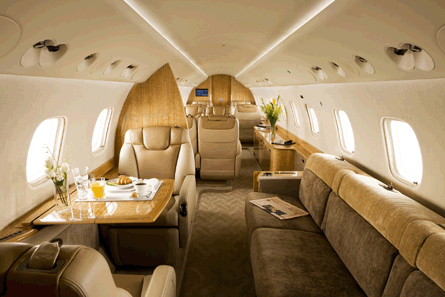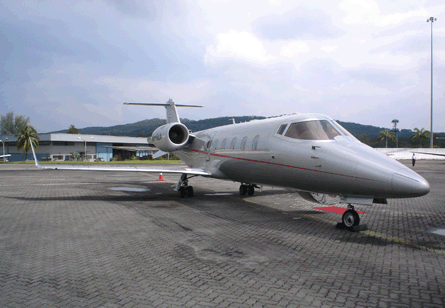At the 2008 Singapore air show, BJETS gave out fancy chocolates and made a big splash with orders for 20 Cessna Citation CJ2+ and 20 Hawker 850XP and 900XP jets.
The business aviation start-up said that it would become the first and largest dedicated pan-Asian fractional ownership, block charter and aircraft management company.
"BJETS will have the biggest fleet of private jets in Asia in its very first year of operations," proclaimed Mark Baier, the company's chief executive and a former NetJets executive. "BJETS will provide a new benchmark for private aviation services," added Bala Ramamoorthy, its founder and managing director, and chief executive of the Briley Group, its biggest shareholder.
 |
|---|
Beaming Cessna and Hawker Beechcraft executives and officials from investor Indian Hotels, operator of the Taj brand of hotels in India and part of the renowned Tata Group, posed with BJETS executives for photos and gave the venture a thumbs up. Two years later, the dream has turned sour.
BJETS has only four aircraft in its fleet, Baier left abruptly in November, Ramamoorthy has been trying to get new investors on board, and Indian Hotels is reportedly keen to sell its stake. The company has delayed the delivery of its remaining jets and may not take them at all, and trimmed its workforce substantially. Operationally, with three out of four aircraft based in India, it has essentially become a charter firm primarily serving that region.
It is easy to blame last year's economic downturn, but the reality is that BJETS - like many others who come to the Asia-Pacific region - overestimated the demand and underestimated the challenges. Some people want to fly private and their number is growing, but it is still a very small market - and one that suffered a setback after the downturn. The Asian charter market is estimated to be only 5% of the US market. Unlike in Europe and the USA, aircraft are not available for charter.
"The region's population, economic activity, and need for transportation to cover distances between business locations - in some cases, where no practical transportation alternative exists - are immense," Ed Bolen, chief executive of the National Business Aviation Association, said two years ago. That remains true, but numerous operational and cultural hurdles remain.
There are few reliable statistics on the Asia-Pacific business aviation fleet. Brazilian manufacturer Embraer says that there were 600-700 jets in 2009 involved in a variety of non-scheduled activity, including corporate travel and medical evacuation. This should grow by an average of 9% annually over the next 10 years to a fleet of 1,100, it adds.
Honeywell's 2009 survey of the outlook for the business aviation market projects a global demand for more than 5,000 aircraft in 2010-14. Asian demand will slip back to around 7% of the total "on lower purchase plans aimed at fleet growth" as the global business aviation market begins to recover.
Honeywell says 2008 "marks the end of an unprecedented five-year industry expansion that began in 2003. After peaking in 2008, new jet deliveries are projected to decline roughly 30% in 2009, followed by a 10-15% decline in 2010 before starting a recovery in 2011."
 |
|---|
© Embraer |
It adds: "The relatively mild impact of the global recession on major Asian economies such as China and India is helping support a more optimistic level of interest in business jets. Since the fleets are relatively small in this region, more volatility is to be expected. As in the other regions, the majority of the change came from increased plans for fleet replacement rather than from expansion plans."
In other words, many people are upgrading or changing aircraft, but growth continues at a snail's pace due to various structural and cultural reasons. Logan Ravishankar, chief executive of MyJet Asia, which is involved in the aircraft management and charter businesses, says not understanding this fact costs many people who try to do business in the region.
"Only those who really know the region, the players and the market will be able to make money - and you have to work damn hard to do that. It is easy to say that you will place 20 aircraft and start a fractional ownership business. But there are many hurdles to that becoming a viable business at this stage," he says. "They must understand the Asian business culture - simply trying to do what works in the USA and Europe, which is what many people are trying to do now, will not work."
Executives from the manufacturers are aware of that, although they have not stopped pushing their products to increase awareness and sound out potential customers - targeting especially the growing number of high net-worth individuals in the region.
Embraer embarked on a 12-country flying tour last year to demonstrate its midsize Legacy 600 executive jet and brought its Phenom 100 to India, Singapore and Australia. "Interest is returning throughout the region," says José Eduardo Costas, vice-president for marketing and sales in the Asia-Pacific region for the company's executive jets division. "We do not know if this can be sustained. However, we are positive that growth will return and we want to be in place to capitalise on that."
Dassault Falcon, which lags some of its competitors in terms of sales in the region, says that several factors will drive the resurgence. "There are fewer restrictions on the use of aircraft in the area, combined with cultural changes that make business aviation more acceptable. And over the past year or two, more banks in Asia, China in particular, have increased their lending for business aviation," says John Rosanvallon, president and chief executive of Dassault Falcon.
Hawker Beechcraft says its "large installed base and an established customer support infrastructure" will help it to increase sales in the region. "That enables current and prospective customers to have confidence in our commitment to this vital market. While the first few months of 2009 were quiet, we continued aggressively building our market share," says Shawn Vick, executive vice-president.
The Asian Business Aviation Association [AsBAA], a regional industry group, says that the "fundamental and essential service" that business jets provide will help in the rebound of the Asian economic markets. "Corporate and industrial leaders are pursuing tools to improve efficiencies, expand markets and develop new businesses. History has shown that one of the most effective ways to achieve these goals is through the use of business aircraft," it says.
Markets such as Hong Kong, Jakarta, Kuala Lumpur, Shanghai, Singapore and Taipei continue to develop, and the potential for business aviation remains viable, it adds. "Perhaps other markets may have a less-defined economic future, but from conversations with industry leaders and financial insiders, we believe that there remain cash buyers and motivated investors in Asia."
 |
|---|
© VistaJet |
Chuck Woods, president of the AsBAA, points out that aircraft orders have begun to pick up as the high net-worth individuals are spotting bargains due to the relatively lower price of business jets. As a result, more than charter and fractional ownership, the biggest business is in aircraft management. Most Asian owners are reluctant to allow their aircraft to be chartered out. Observers say this situation is unlikely to change any time soon.
"A high percentage of the business jets in Asia are unavailable for charter. That means the aircraft management business will continue to grow while the charter and fractional segments will continue to face challenges in Asia," adds Woods, who is also chief executive of Macau-based Jet Asia.
The best approach, especially for those who are keen to get into the charter business, will be slowly, slowly. Austria-based VistaJet, for example, based two aircraft - a Bombardier Challenger 605 and a Challenger 850 - in early 2009 at the Subang SkyPark near Malaysia's capital Kuala Lumpur. It added a third aircraft, a Learjet 60XR, later that year only after it saw demand picking up.
As the industry recovers, observers say that it should use the lull period to build the infrastructure and push governments to ease regulations that impede growth.
"If I had the money, I would put it in into developing the infrastructure," says Woods. Hong Kong is a model, with its extensive FBO, parking and maintenance space at its Business Aviation Centre helping to create a vibrant business aviation market.
Smaller airfields in major cities could be redeveloped into business aviation hubs. Apart from Subang, Jet Aviation and Hawker Pacific have similar facilities in Singapore's Seletar Aerospace Park. These are also coming up in China, India, Indonesia, the Philippines and Thailand.
Subang SkyPark's executive director Ravindran Menon says the demand is there. "Hong Kong's success shows that when you build infrastructure, aircraft will come," says Menon.
Long-standing barriers include high import taxes, delays in approving flying and landing permits, high fees and restrictions on the use of airspace. Governments around the region, says MyJet's Ravishankar, do not get the utility of corporate jets. "For many users, they are a necessity and not a luxury. Governments provide the basic services and then have high charges - they don't realise that there is a link between corporate aviation, economic growth and investments. People want to buy jets, but are put off by red tape, taxes and fees," he adds.
"The situation has improved, but it is not enough. The Asian business aviation market has potential, but all of this must be resolved before it can be realised. Growth will continue, albeit at a slow pace. Those who expect it to be otherwise are badly mistaken."
Source: Flight International























